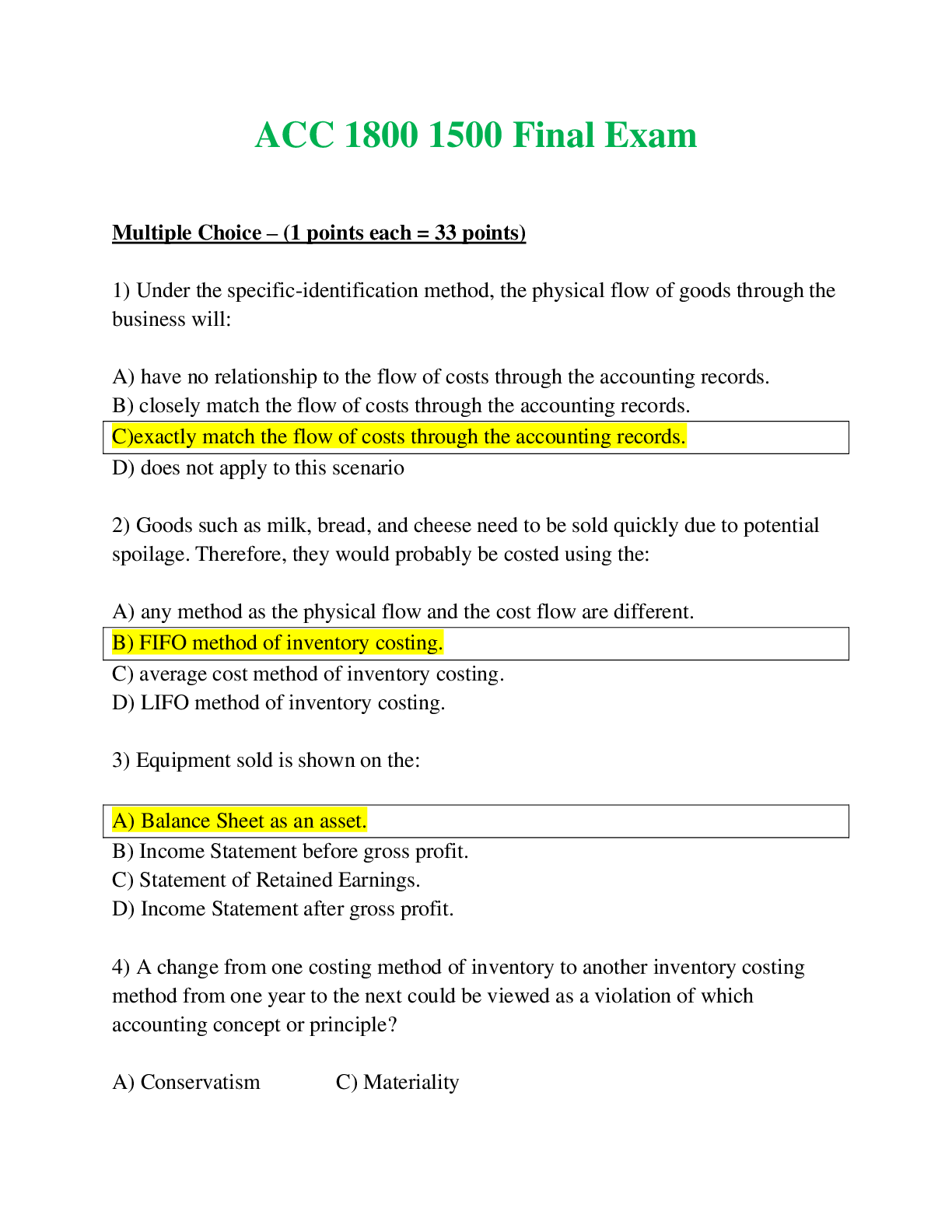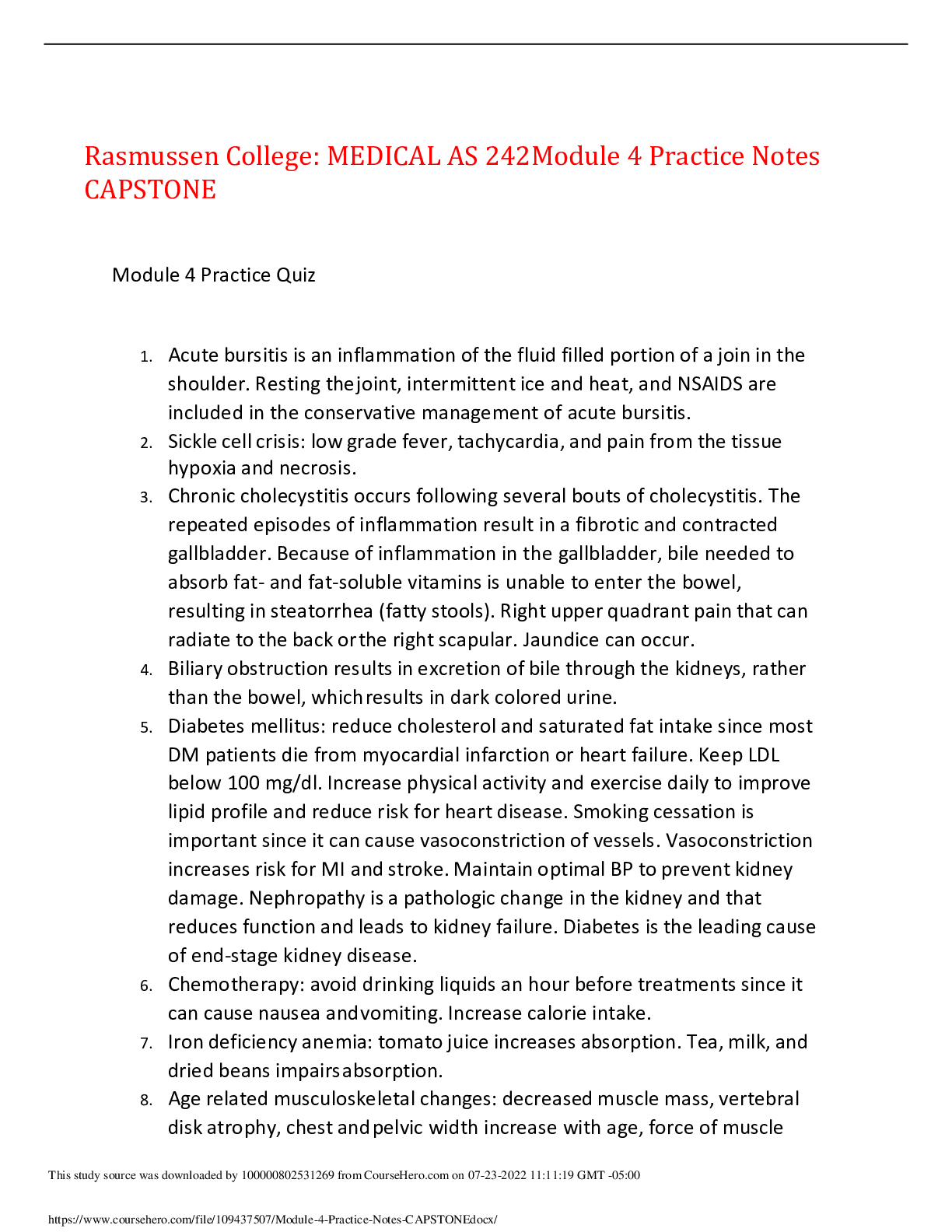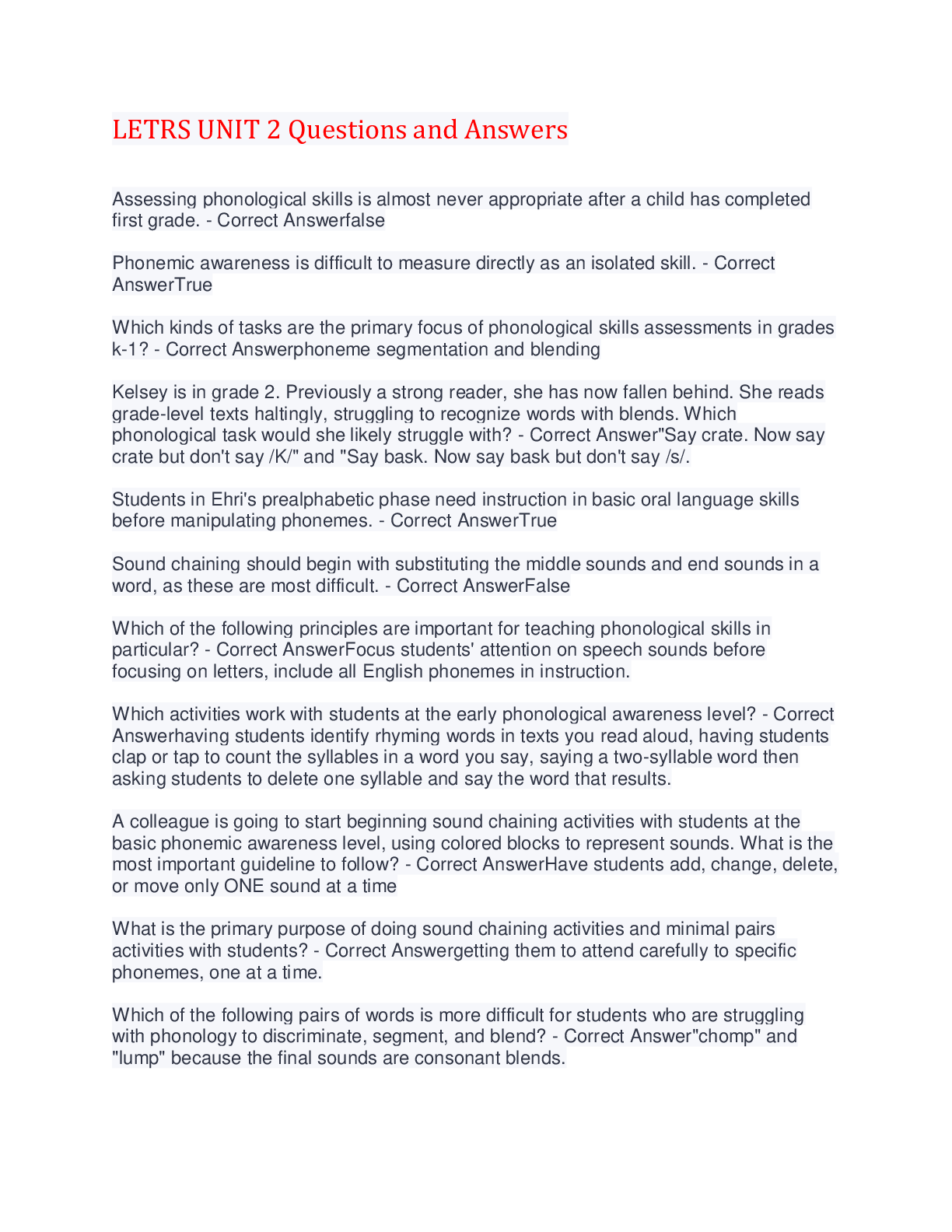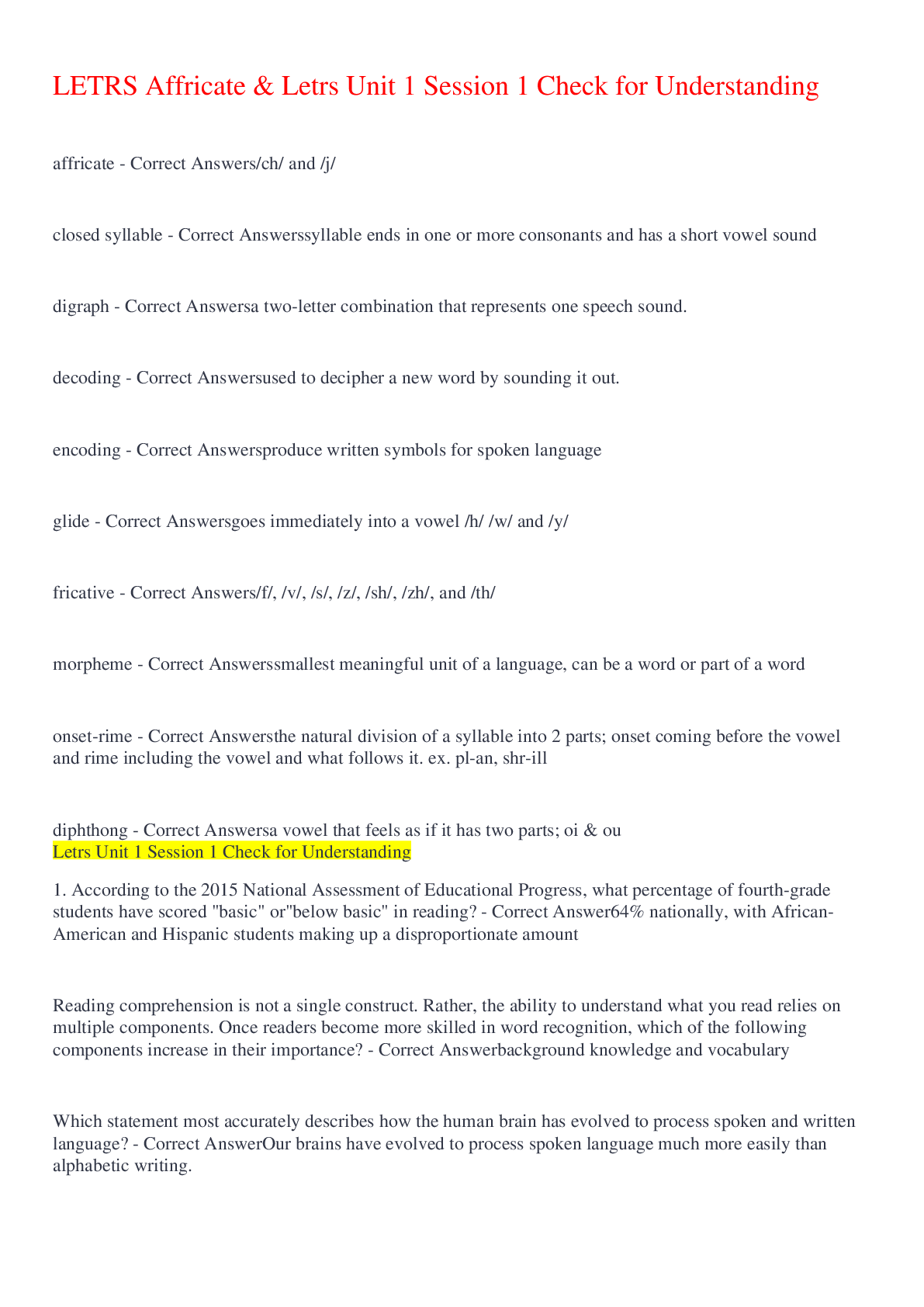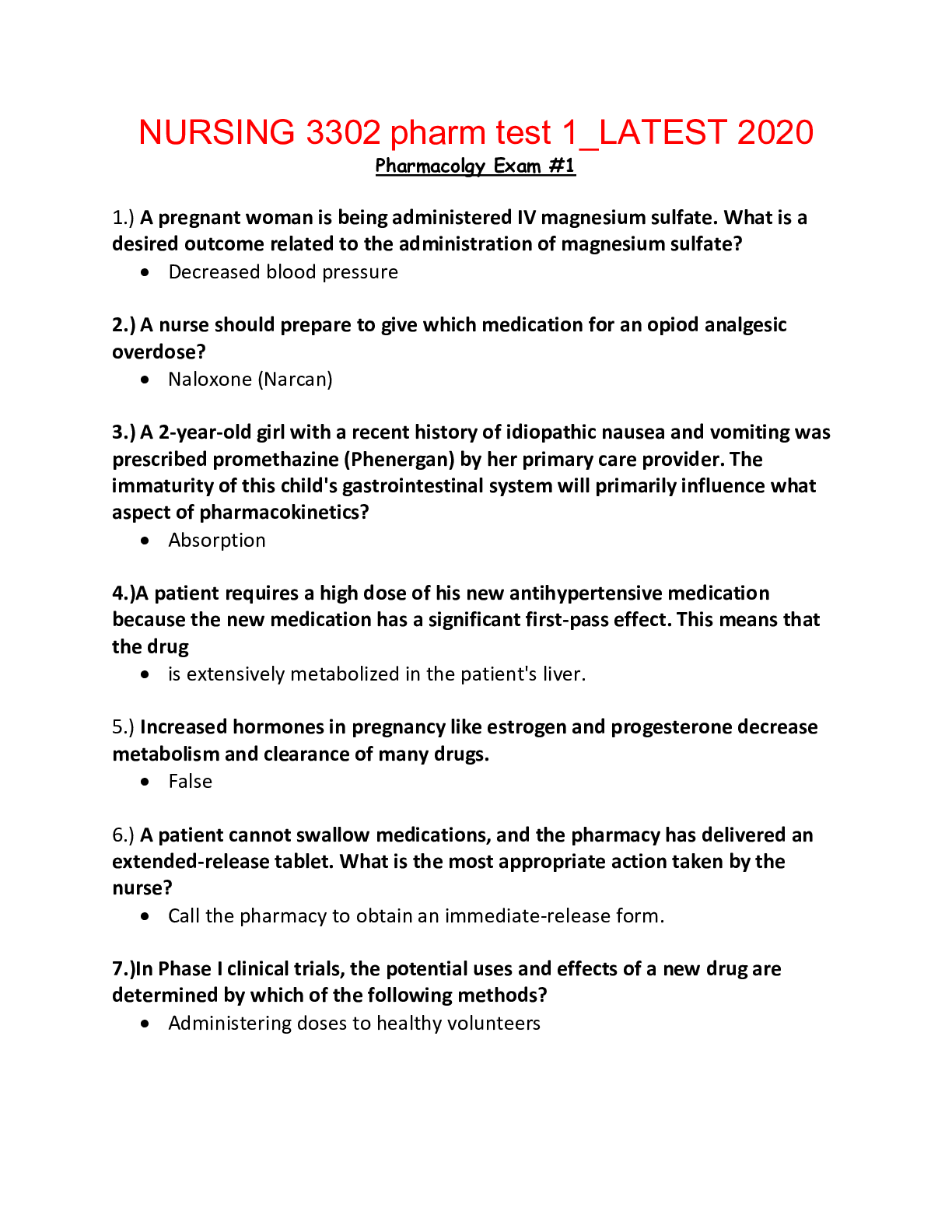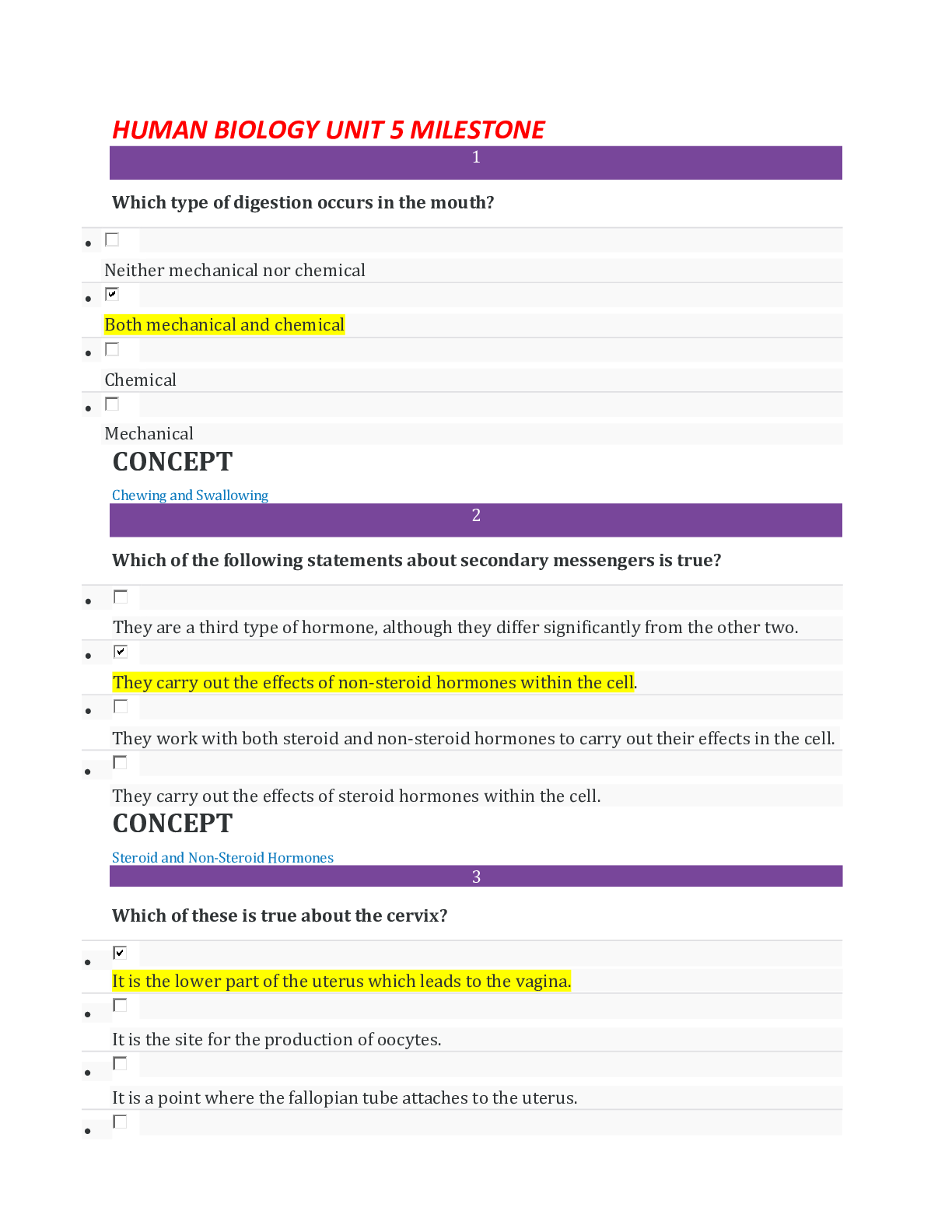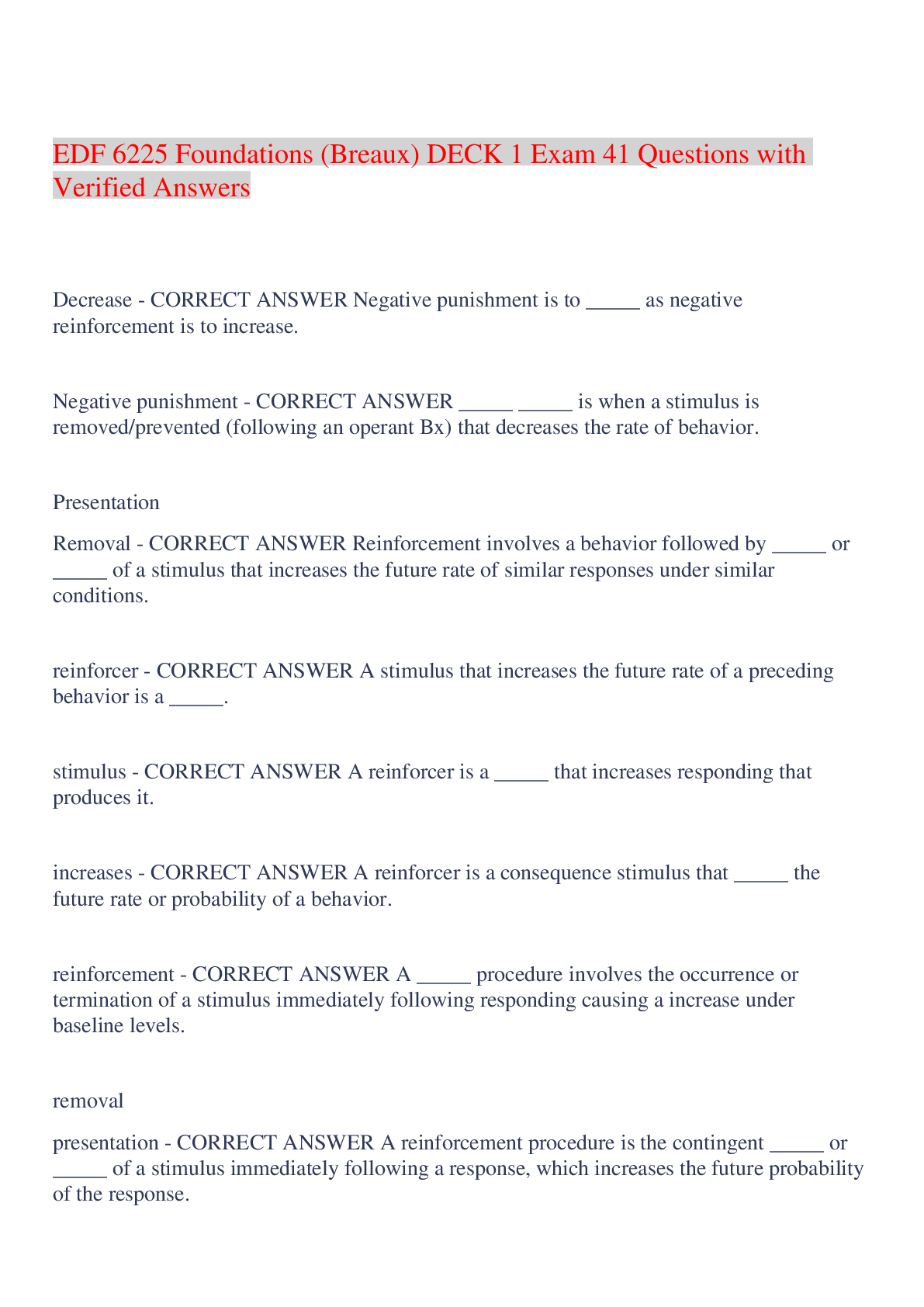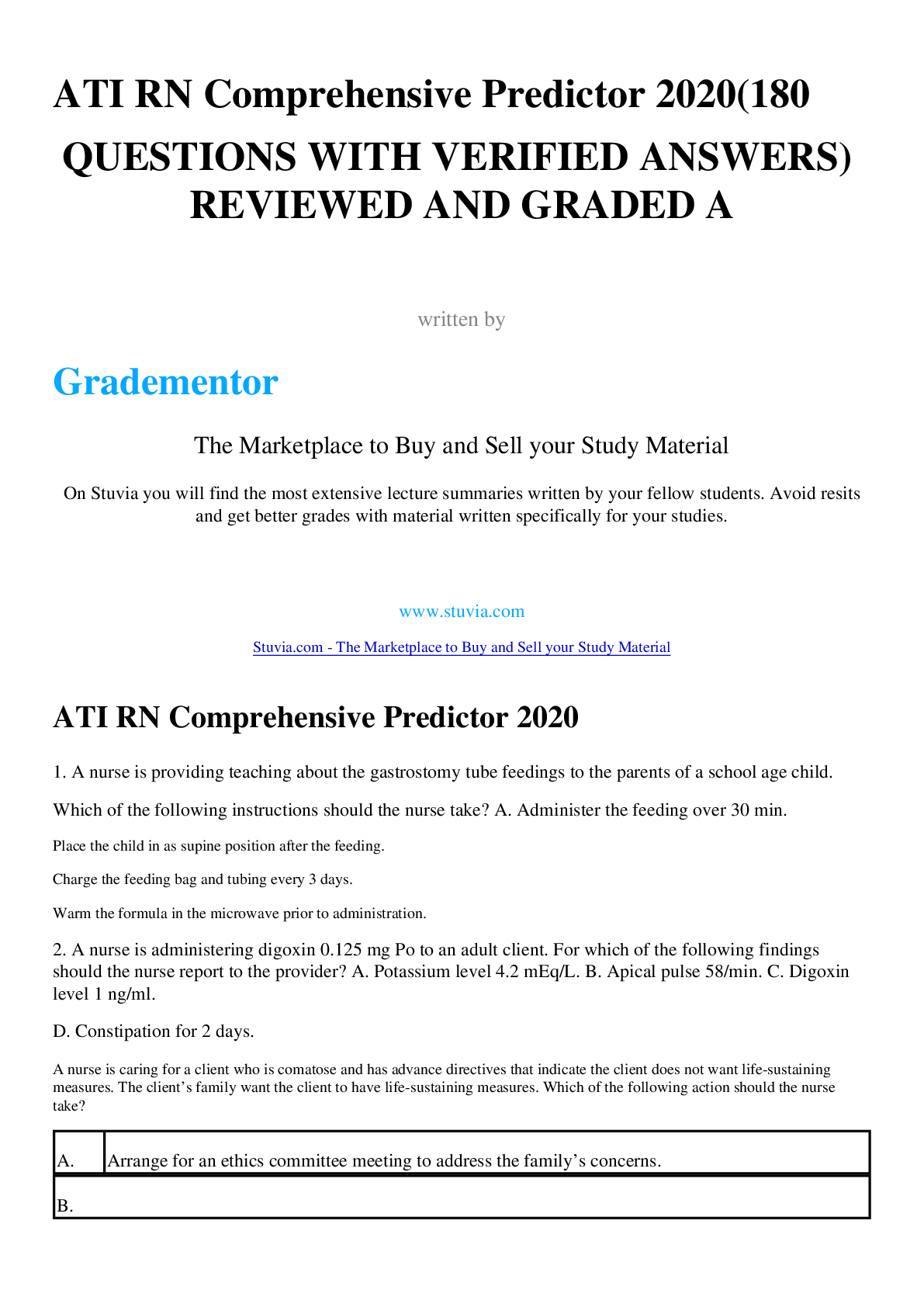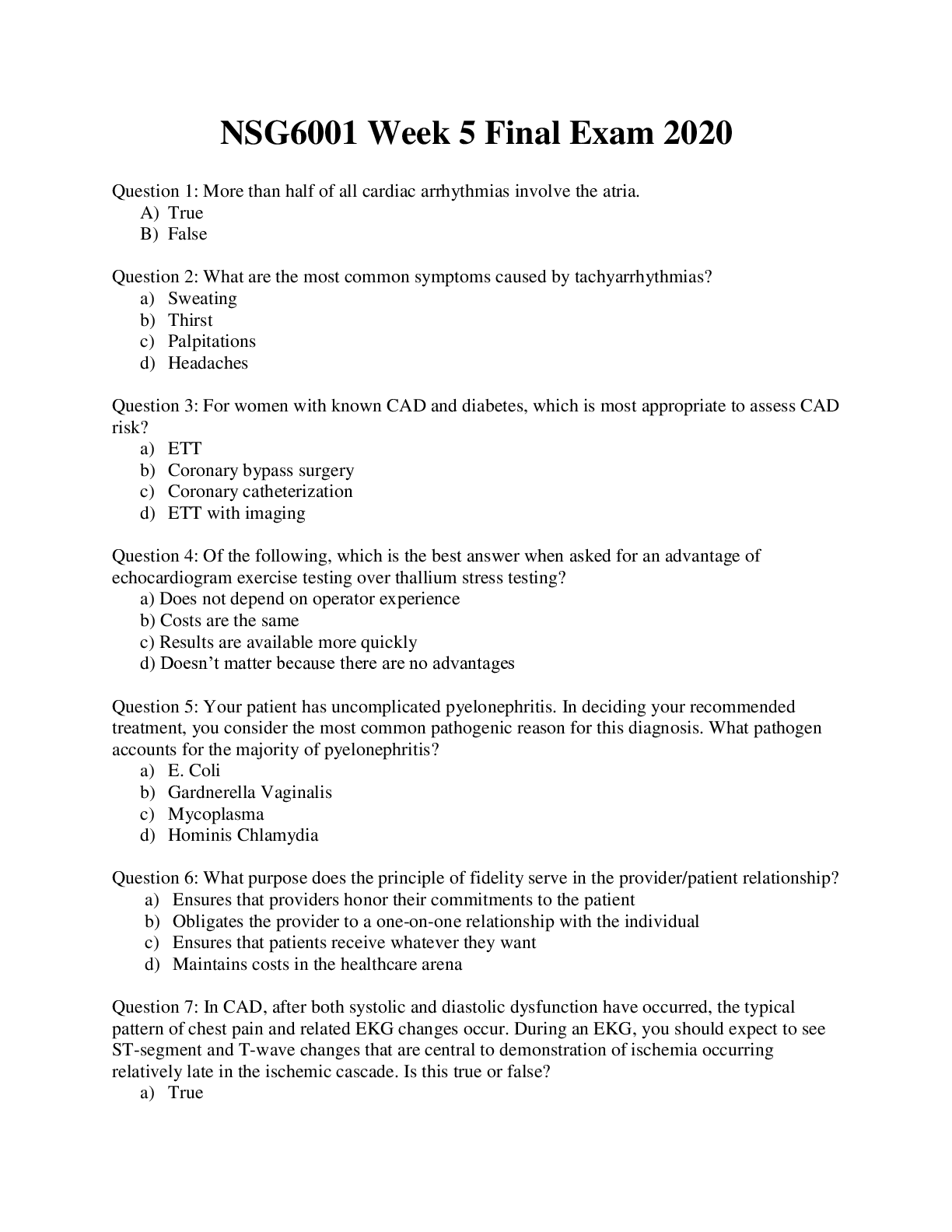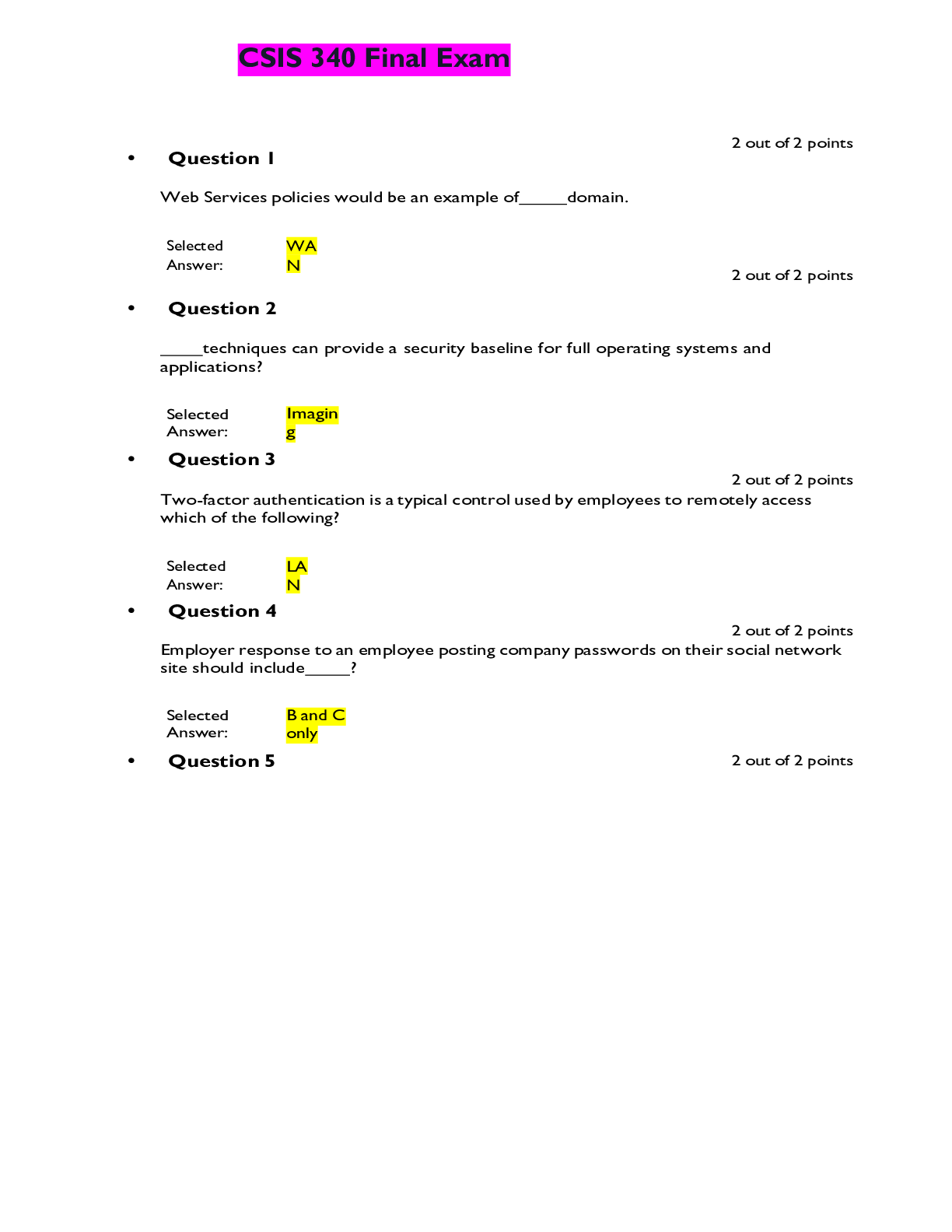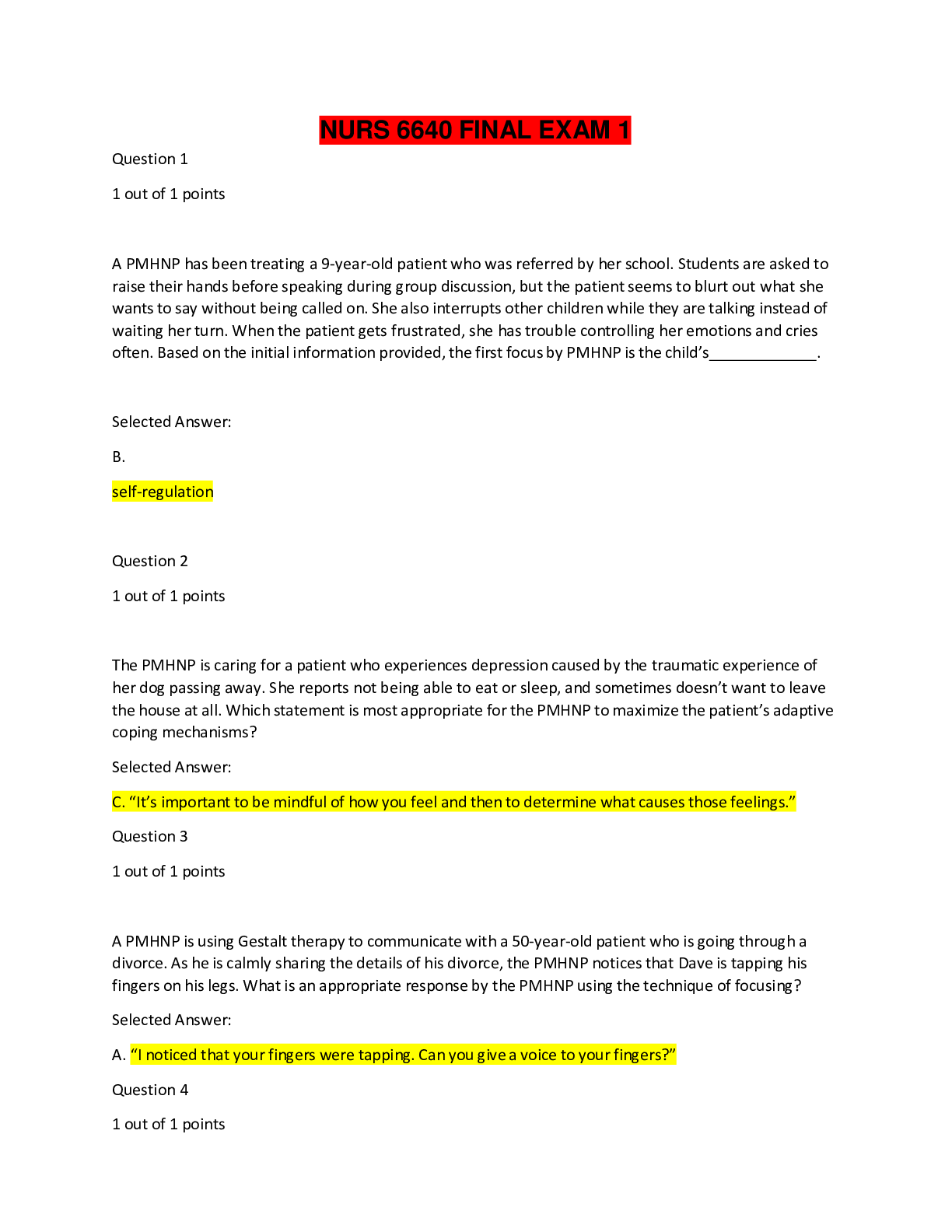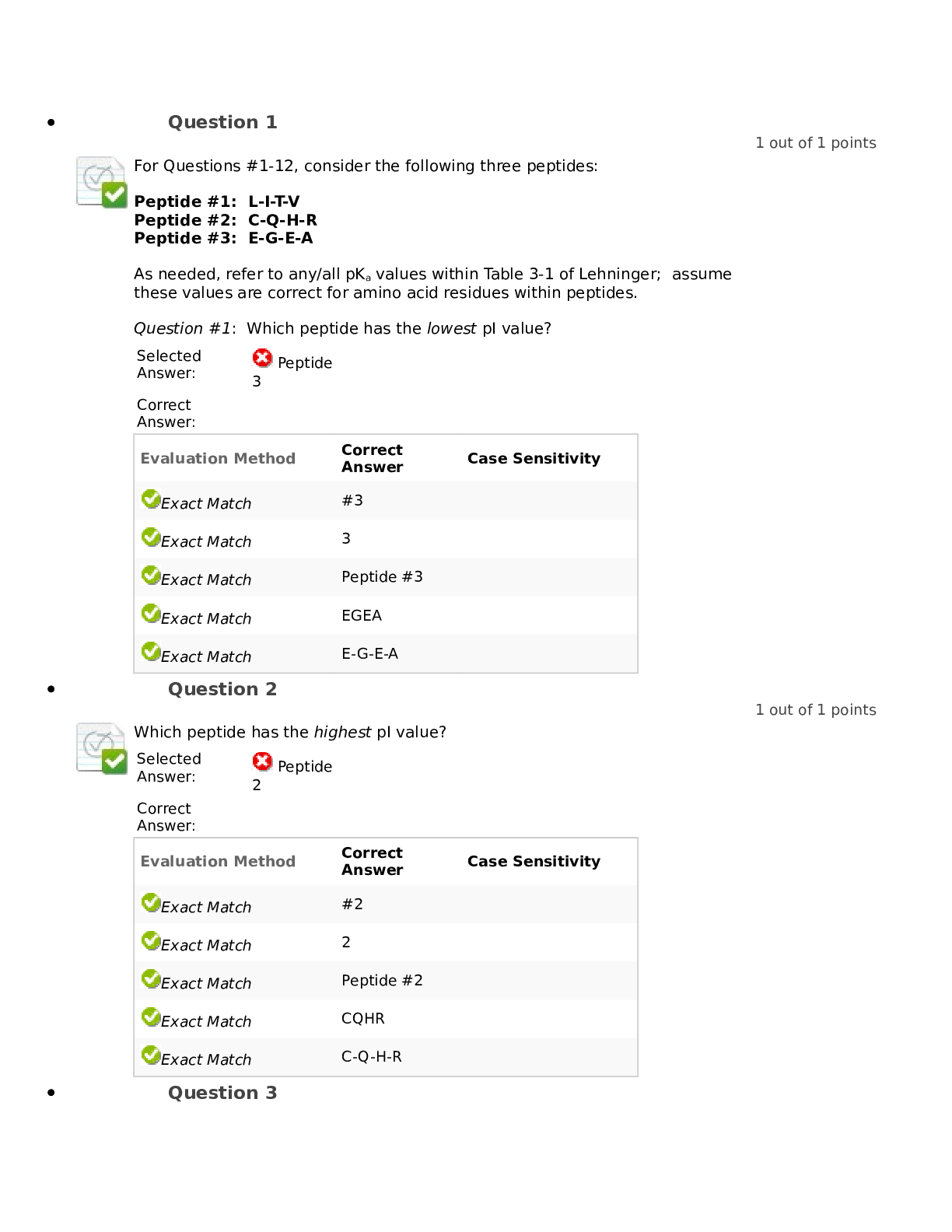ABCTE Biology Terms Exam 143 Questions with Verified Answers,100% CORRECT
Document Content and Description Below
ABCTE Biology Terms Exam 143 Questions with Verified Answers Acidic solution - CORRECT ANSWER contains more hydrogen ions than hydroxide ions basic solution - CORRECT ANSWER contains more hydrox... ide ions than hydrogen ions colligative properties - CORRECT ANSWER properties of a solution that depend only on the number of particles dissolved in it, not the properties of the particles themselves. The main ones are boiling point elevation and freezing point depression. boiling point elevation - CORRECT ANSWER the difference in temperature between the boiling point of a solution and the boiling point of the pure solvent freezing point depression - CORRECT ANSWER the difference in temperature between the freezing point of a solution and the freezing point of the pure solvent nuetralization reaction - CORRECT ANSWER a reaction in which an acid and a base react in aqueous solution to produce a salt and water pH scale - CORRECT ANSWER measurement system used to indicate the concentration of hydrogen ions (H+) in solution; ranges from 0 to 14 catalyst - CORRECT ANSWER substance that speeds up the rate of a chemical reaction reversible reaction - CORRECT ANSWER a chemical reaction in which the products reform the original reactants activation energy - CORRECT ANSWER Energy needed to get a reaction started endothermic reaction - CORRECT ANSWER A reaction that ABSORBS energy in the form of heat exothermic reaction - CORRECT ANSWER A reaction that releases energy in the form of heat energy flow - CORRECT ANSWER release of stored energy through chemical reactions chemical potential energy - CORRECT ANSWER Energy stored in chemical bonds kinetic energy - CORRECT ANSWER energy of motion Empiricism - CORRECT ANSWER the view that knowledge originates in experience and that science should, therefore, rely on observation and experimentation scientific realism - CORRECT ANSWER philosophy of identifying structure and cause in science independent variable - CORRECT ANSWER The experimental factor that is manipulated; the variable whose effect is being studied. dependent variable - CORRECT ANSWER The outcome factor; the variable that may change in response to manipulations of the independent variable. controlled variable (constant) - CORRECT ANSWER A variable that is not changed Theory - CORRECT ANSWER well-tested explanation that unifies a broad range of observations scientific law - CORRECT ANSWER a statement of fact that explains a relationship in nature that is generally accepted to be true and universal Mass - CORRECT ANSWER kilogram (kg) time - CORRECT ANSWER second (s) length - CORRECT ANSWER meter (m) electrical current - CORRECT ANSWER ampere, A thermodynamic temperature - CORRECT ANSWER Kelvin (K) Amount of substance - CORRECT ANSWER mole (mol) luminous intensity - CORRECT ANSWER candela (cd) absolute zero - CORRECT ANSWER The coldest temperature, 0 Kelvin, that can be reached. It is the hypothetical temperature at which all molecular motion stops. Precision - CORRECT ANSWER a measure of how close a series of measurements are to one another Accuracy - CORRECT ANSWER A description of how close a measurement is to the true value of the quantity measured. significant digits - CORRECT ANSWER non-zero digits, seros between non-zero digits, final zeros after a decimal - 0.0038 has two significant digits - 18,300 has three significant digits mathematical precision - CORRECT ANSWER the results of a mathematical operation can never be more precise than the least precise measurement mega - CORRECT ANSWER 10^6 Giga - CORRECT ANSWER 10^9 kilo - CORRECT ANSWER 10^3 deci - CORRECT ANSWER 10^-1 centi - CORRECT ANSWER 10^-2 milli - CORRECT ANSWER 10^-3 micro - CORRECT ANSWER 10^-6 nano - CORRECT ANSWER 10^-9 derived units - CORRECT ANSWER combinations of SI base units area - CORRECT ANSWER m^2 Volume - CORRECT ANSWER m^3 speed/velocity - CORRECT ANSWER m/s Acceleration - CORRECT ANSWER m/s^2 Momentum - CORRECT ANSWER N * s or kg * m/s Density (mass density) - CORRECT ANSWER kilograms / meters ^ 3 ( kg / m ^ 3) heat capacity, entropy - CORRECT ANSWER joule per kelvin (J/K) molar heat capacity, molar entropy - CORRECT ANSWER joule per kelvin mole (J / K * mol or kg * m^2/ s^2 * K * mol specific heat capacity, specific entropy - CORRECT ANSWER Joule per kilogram Kelvin (J/kg*K or m^2/s^2 * K) Frequency - CORRECT ANSWER Hertz (Hz) Force - CORRECT ANSWER newton (N) electrical charge - CORRECT ANSWER Coulomb, C electrical potential - CORRECT ANSWER volt (V) Electrical capacitance - CORRECT ANSWER Farad (F) electrical resistance - CORRECT ANSWER Ohm (Ω) energy, heat, work - CORRECT ANSWER joule (J) pressure - CORRECT ANSWER Pascal (Pa) Power - CORRECT ANSWER Watts (W) temperature - CORRECT ANSWER degree C (C) or K-273.16 yards to inches - CORRECT ANSWER 1 yard = 36 inches yards in a mile - CORRECT ANSWER 1760 = 1mile = 5280 ft acres to yard - CORRECT ANSWER acre = 4840 yd Joule (J) - CORRECT ANSWER A unit of energy: 1 J = 0.239 cal; 1 cal = 4.184 J. kilowatt-hour (kWh) - CORRECT ANSWER A unit of energy equal to 3.6 million joules (MJ) Fahrenheit to Celsius - CORRECT ANSWER C=(F-32)/1.8 Kelvin to Fahrenheit - CORRECT ANSWER F = 9/5 (K - 273) + 32 exponential growth model - CORRECT ANSWER N(t)=N0e^rt A growth model that estimates a population's future size (Nt) after a period of time (t), based on the intrinsic growth rate (r) and the number of reproducing individuals currently in the population (N0) Standard Deviation (SD) - CORRECT ANSWER A measure of variability that indicates the average difference between the scores and their mean. logarithmic relationship - CORRECT ANSWER to describe quantities having very large ranges x and log(y) have a direct relationship log(y)=x Multimeter - CORRECT ANSWER A measuring instrument for current, voltage, and resistance Micrometer screw gauge - CORRECT ANSWER Used to measure small distances. Each division is 0.001 cm or 0.01 mm in width. Compounds and mixtures - CORRECT ANSWER Compounds - Substance composed of two or more different elements, chemical bonds Mixtures - A substance made by other different substances combined. Unbonded different materials heterogeneous mixture - CORRECT ANSWER A mixture in which different materials can be distinguished easily homogeneous mixture - CORRECT ANSWER A mixture in which substances are evenly distributed throughout the mixture Elements - CORRECT ANSWER any substance that cannot be broken down into simpler substances Atom - CORRECT ANSWER Smallest particle of an element ionic compound - CORRECT ANSWER A compound that consists of positive and negative ions molecular compound - CORRECT ANSWER a chemical compound whose simplest units are molecules Extrinsic Properties - CORRECT ANSWER properties that change based on the amount of substance present i.e mass, volume Intrinsic Properties - CORRECT ANSWER properties that do not change based on the amount present i.e density, boiling point, freezing point, conductivity atomic number - CORRECT ANSWER the number of protons in the nucleus of an atom mass number - CORRECT ANSWER Number of protons and neutrons atomic mass - CORRECT ANSWER the weighted average of the masses of the isotopes of an element electron density - CORRECT ANSWER gives the probability that an electron will be found in a particular region of an atom Metals - CORRECT ANSWER Elements that are good conductors of electric current and heat. hard and shiny Nonmetals - CORRECT ANSWER Elements that are poor conductors of heat and electric current. soft, brittle, and many are gases at room temp. Metalloids - CORRECT ANSWER elements with properties that fall between those of metals and nonmetals Lanthanides and Actinides - CORRECT ANSWER aka "rare earth metals" Lanthanides- shiny reactive metals. Actinides - radioactive, means they are unstable alkali metals - CORRECT ANSWER reactive metals column 1 alkaline earth metals - CORRECT ANSWER metallic elements in group 2 of the periodic table which are harder than the alkali metals and are also less reactive i.e Mg, Ca Transition Metals - CORRECT ANSWER Groups 3-12, 1-2 electrons in the outer energy level, less reactive than alkali-earth metals, undergo few chemical reactions. shiny, good conductor of thermal energy and electrical current, high density halogen gases - CORRECT ANSWER Group 17: gases, liquids, and solids, the most reactive non-metals, forming salts with metallic elements noble gases - CORRECT ANSWER Elements in group 18 of the periodic table. Have no charge and are gases under normal conditions. (Helium, Neon, Argon, Krypton, Xenon, Radon) valence electrons - CORRECT ANSWER The electrons in the outermost shell (main energy level) of an atom; these are the electrons involved in forming bonds. ionic bond - CORRECT ANSWER Formed when one or more electrons are transferred from one atom to another, mostly bonds between metals and non-metal i.e Na+ + Cl- -> NaCl covalent bond - CORRECT ANSWER A chemical bond that involves sharing a pair of electrons between atoms in a molecule, non-metal atoms metallic bond - CORRECT ANSWER a bond formed by the attraction between positively charged metal ions and the electrons around them, aids conduction hydrogen bonds - CORRECT ANSWER Very weak bonds; occurs when a hydrogen atom in one molecule is attracted to the electrostatic atom in another molecule Cation - CORRECT ANSWER A positively charged ion Anion - CORRECT ANSWER A negatively charged ion properties of ionic compounds - CORRECT ANSWER compounds composed of cations and anions, form crystals, strong interlocking bonds, high melting point, brittle solids that cleave clean lines, do not conduct electricity well unless in sol'n properties of covalently bonded compounds - CORRECT ANSWER the basic structural unit is a molecule, react as individual units, gases or liquids at room temperature, lower melting points, i.e. polymers - long chain carbons Polymers - CORRECT ANSWER molecules composed of many monomers; makes up macromolecules i.e long chain carbons phase diagram - CORRECT ANSWER a graph showing the conditions at which a substance exists as a solid, liquid, or vapor polyatomic ion - CORRECT ANSWER a tightly bound group of atoms that behaves as a unit and has a positive or negative charge synthesis reaction - CORRECT ANSWER a reaction in which two or more substances combine to form a new compound decomposition reaction - CORRECT ANSWER a reaction in which a single compound breaks down to form two or more simpler substances combustion reaction - CORRECT ANSWER a chemical reaction that occurs when a substance reacts with oxygen, releasing energy in the form of heat and light (oxidation) single-displacement reaction - CORRECT ANSWER chemical reaction in which one element replaces another element in a compound double-displacement reaction - CORRECT ANSWER the ions of two compounds exchange places Avogadro's number - CORRECT ANSWER number of representative particles in a mole, 6.02 X 10^23 molar mass - CORRECT ANSWER the mass of one mole of a pure substance molar volume - CORRECT ANSWER polar solvent - CORRECT ANSWER Any liquid such as water that can easily dissolve polar solutes. nonpolar solvents - CORRECT ANSWER dissolve nonpolar solutes Solutes - CORRECT ANSWER substance dissolved in a solution Solvent - CORRECT ANSWER In a solution, the substance in which the solute dissolves. nuetralization reaction - CORRECT ANSWER acids and bases react to form water and a salt saturated solution - CORRECT ANSWER a solution that cannot dissolve any more solute under the given conditions unsaturated solution - CORRECT ANSWER any solution that can dissolve more solute at a given temperature supersaturated solution - CORRECT ANSWER a solution that holds more dissolved solute than is required to reach equilibrium at a given temperature parts of a phase diagram: - CORRECT ANSWER -lines=lines of equilibrium (where phase changes take place) -top point of last line=critical point (beyond this liquids and gases are indistinguishable) -base of crack=triple point (all three phases are in equilibrium) Diffusion - CORRECT ANSWER the process by which molecules move from an area of higher concentration to an area of lower concentration potential energy diagram - CORRECT ANSWER a diagram that shows the changes in potential energy that takes place during a chemical reaction latent heat - CORRECT ANSWER heat absorbed or radiated during a change of phase at a constant temperature and pressure spiral galaxies - CORRECT ANSWER disk-shaped galaxy with arms spiraling outwards and a bulge in the center, e.g. milky way elliptical galaxies - CORRECT ANSWER a galaxy that looks like round or flattened balls and have little dust and gas between the stars. irregular galaxies - CORRECT ANSWER Galaxies that look neither spiral nor elliptical. Quasars - CORRECT ANSWER young, active, enormously bright, distant galaxies with a giant black hole and lots of gas at its center Hubble's Law - CORRECT ANSWER states that the farther away a galaxy is, the faster it is moving away from us Nebula - CORRECT ANSWER a cloud of gas and dust in space Protostar - CORRECT ANSWER A contracting cloud of gas and dust with enough mass to form a star nuclear fusion reaction - CORRECT ANSWER When nuclei of two atoms fuse together producing a heavier atoms, giving off tremendous amounts of energy. life cycle of stars - CORRECT ANSWER Hydrogen gas nebula > protostar > main sequence star > then it splits, it goes: 1. Red giant > white dwarf > black dwarf - or 2. Red super giant > supernova occurs > black hole or neutron star red giant - CORRECT ANSWER A large, reddish star that expands and cools once it runs out of hydrogen fuel neutron stars - CORRECT ANSWER the small, dense remains of a high-mass star after a supernova Black Dwarf - CORRECT ANSWER A white dwarf that has burnt out completely. white dwarf - CORRECT ANSWER Stage in which a star has used up its helium and its outer layers escape into space, leaving behind a hot, dense core that contracts Supernova - CORRECT ANSWER A gigantic explosion in which a massive star collapses and throws its outer layers into space Supergiant - CORRECT ANSWER an extremely bright star of very large diameter and low density [Show More]
Last updated: 1 year ago
Preview 1 out of 12 pages

Buy this document to get the full access instantly
Instant Download Access after purchase
Buy NowInstant download
We Accept:

Reviews( 0 )
$10.50
Can't find what you want? Try our AI powered Search
Document information
Connected school, study & course
About the document
Uploaded On
Oct 15, 2023
Number of pages
12
Written in
Additional information
This document has been written for:
Uploaded
Oct 15, 2023
Downloads
0
Views
79




